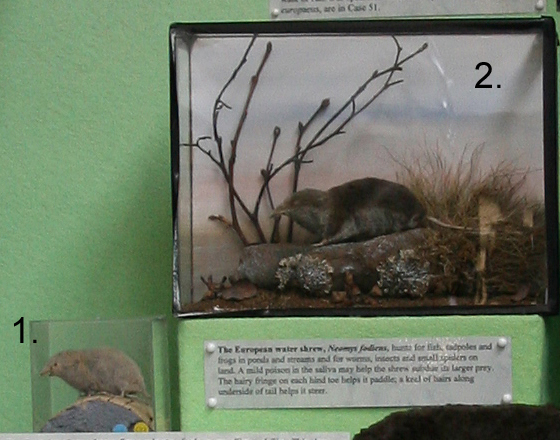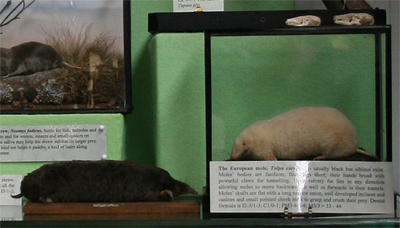
CLADE LAURASIATHERIA
ORDER EULIPOTYPHLA
SHREWS, MOLES AND HEDGEHOGS
Family Soricidae: 300 species of shrews in 23 genera.
Family Talpidae: 42 species of moles in 17 genera.
Family Erinaceidae: 17 species of hedgehogs in 7 genera.
Shrews, moles and hedgehogs are small animals with long narrow pointed and usually mobile snouts. They feed on invertebrates, insects and earthworms, and vegetable matter. Their dental formulae are variable and adapted to hold and crush invertebrates. The three families are easy to tell apart.
Shrews are very small, fierce, furry, mostly solitary mammals, that produce distasteful secretions to deter predators. Most species live in moist microhabitats in forests, woods and grass lands; some are aquatic. A shrew’s very high metabolic rate forces it to spend all its time hunting for any prey it can handle.

1. The Eurasian pigmy shrew, Sorex minutus, feeds on woodlice and flies. This shrew, Britain’s smallest mammal, is so small it will starve to death if it is does not eat all the time. Shrews have well differentiated teeth with a variable dental formula of I3/1-2; C1/0-1; PM1-3/1; M3/3 = 26 - 32.
2. The European water shrew, Neomys fodiens, hunts for fish, tadpoles and frogs in ponds and streams and for worms, insects and small spiders on land. A mild poison in the saliva may help the shrew subdue its larger prey. The hairy fringe on each hind toe helps it paddle; a keel of hairs along underside of tail helps it steer.
Most moles are fossorial animals highly adapted for digging the tunnels, in which they live and hunt for prey.

The European mole, Talpa europea, is usually black but albinos exist. Moles’ bodies are fusiform; their legs short; their hands broad with powerful claws for tunnelling. Their velvety fur lies in any direction allowing moles to move backwards as well as forwards in their tunnels. Moles’ skulls are flat with a long narrow snout, well developed incisors and canines and small pointed cheek teeth to grasp and crush their prey. Dental formula is I2-3/1-3; C1/0-1; PM3-4/3-4; M3/3 = 33 - 44.
Hedgehogs have sharp spines and can roll up into a ball to protect their vulnerable hairy areas. Their short limbs, with five digits on each foot, allow them to walk or run. Our specimens of the European hedgehog, Erinaceus europaeus, are in the Introductory Case.
Tenrecs and golden moles used to be classified in the Order Insectivora, together with the shrews, moles and hedgehogs. The web pages entitled ‘the Tree of Life’ explains how molecular analyses led to the members of the Order Insectivora being split between two separate orders - the Eulipotyphla and the Afrosoricida. As a result of these recent changes in taxonomy our tenrecs have been moved into the case which houses other other Afrotherians.






